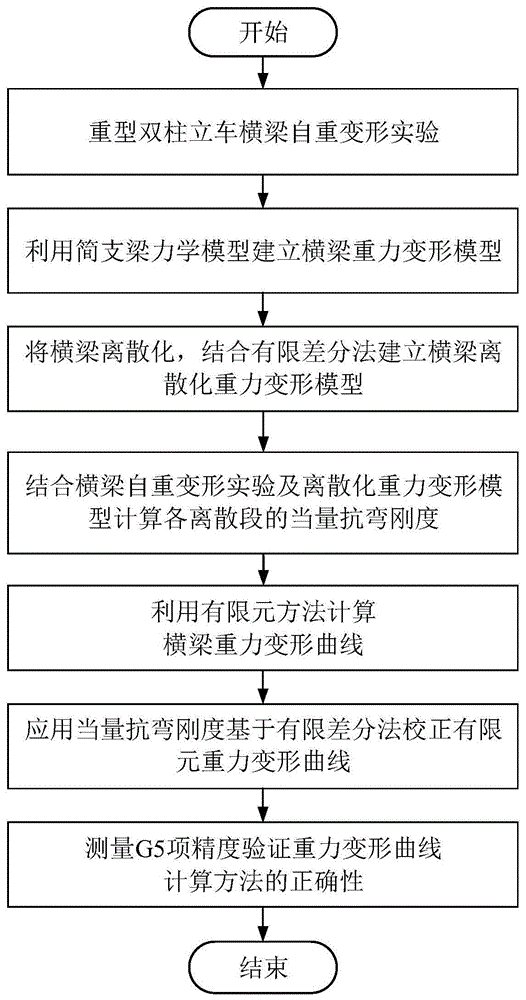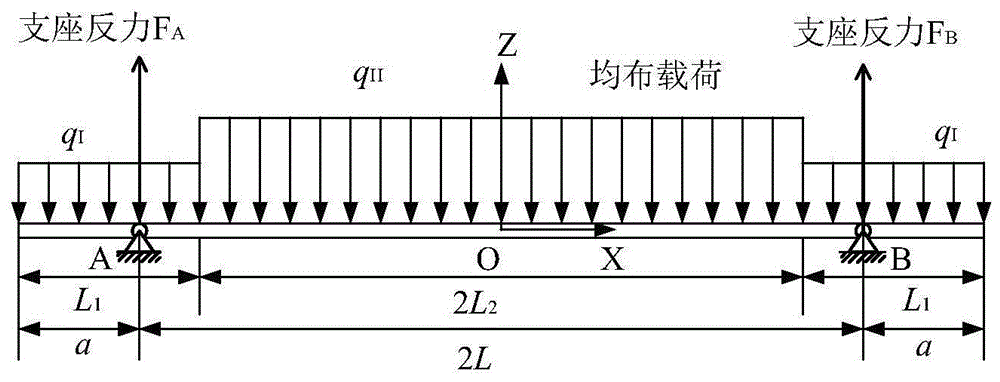Prediction method of gravity deformation of beam of heavy-duty double-column vertical car based on finite difference method
A finite difference method and gravity deformation technology, used in large fixed members, program control, instruments, etc., can solve problems such as large difference in actual deformation value, accurate calculation of beam gravity deformation curve, etc., to reduce repair times, reduce installation costs and The effect of installation man-hours
- Summary
- Abstract
- Description
- Claims
- Application Information
AI Technical Summary
Problems solved by technology
Method used
Image
Examples
specific Embodiment approach 1
[0028] In the method for predicting the gravity deformation of the beam of a heavy-duty double-column vertical car based on the finite difference method in this embodiment, the calculation method for the gravity deformation curve of the beam is realized through the following steps:
[0029] Step 1: Simulate the actual assembly conditions to design the self-weight deformation experiment of the heavy-duty machine tool beam, and obtain the self-weight deformation curve of the beam under the condition of uneven material;
[0030] Step 2: Using the theory of material mechanics, simplify the beam into a simply supported beam mechanical model according to the force of the beam under its own weight;
[0031] Step 3: discretize the beam into a group of discrete micro-segments, discretize the mechanical model of the simply supported beam obtained in step 2, and then combine the finite difference method to establish a discretization model of the gravity deformation of the beam;
[0032] ...
specific Embodiment approach 2
[0036] The difference from the specific embodiment 1 is that in the method for predicting the gravity deformation of the beam of the heavy-duty double-column vertical car based on the finite difference method in this embodiment, the self-weight deformation experiment of the beam of the heavy-duty machine tool described in step 1 is specifically as follows:
[0037] Step 11. According to the shape of the beam, take the midpoint of the beam in the horizontal plane where the beam is located as the origin O of the coordinate system, and establish a Cartesian coordinate system. The direction of the X-axis is along the direction of the guide rail of the beam, and positive to the right, and the Y-axis is perpendicular to the X-axis. And upward is positive, and the positive direction of the Z axis conforms to the right-hand rule; figure 2 shown;
[0038] Step 12: Lay the beam horizontally, and use an autocollimator to measure the Z-direction straightness data on the surface of the gu...
specific Embodiment approach 3
[0041] The difference from the specific embodiment 1 or 2 is that the method for predicting the gravity deformation of the beam of the heavy-duty double-column vertical vehicle based on the finite difference method in this embodiment, the method for obtaining the self-weight deformation curve of the beam described in step 1 is specifically:
[0042] Make a difference between the Z-direction straightness data measured after placing the beam on its side as described in step 13 until the deformation is stable, and the Z-direction straightness data measured after placing the beam horizontally as described in step 12 to obtain a difference, and use the difference The values are plotted as the self-weight deformation curve of the beam.
PUM
 Login to View More
Login to View More Abstract
Description
Claims
Application Information
 Login to View More
Login to View More - R&D
- Intellectual Property
- Life Sciences
- Materials
- Tech Scout
- Unparalleled Data Quality
- Higher Quality Content
- 60% Fewer Hallucinations
Browse by: Latest US Patents, China's latest patents, Technical Efficacy Thesaurus, Application Domain, Technology Topic, Popular Technical Reports.
© 2025 PatSnap. All rights reserved.Legal|Privacy policy|Modern Slavery Act Transparency Statement|Sitemap|About US| Contact US: help@patsnap.com



